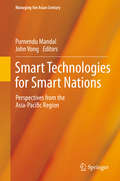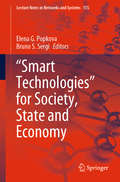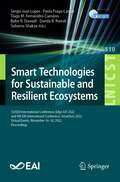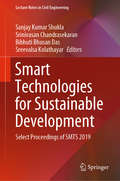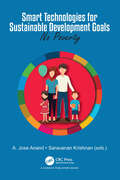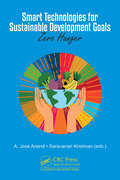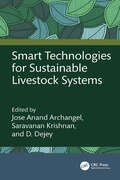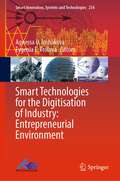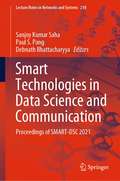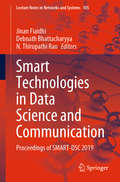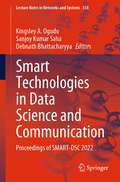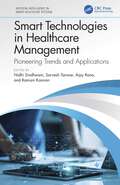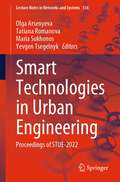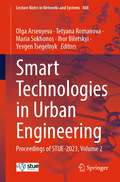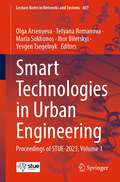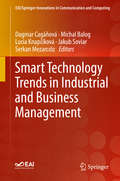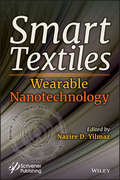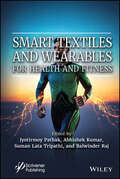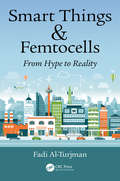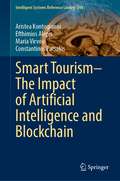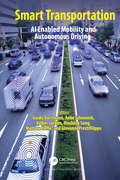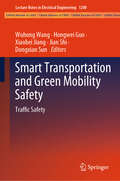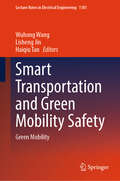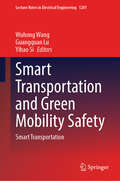- Table View
- List View
Smart Technologies for Smart Cities (EAI/Springer Innovations in Communication and Computing)
by Mohammad M. Banat Sara PaivaThis book provides a scholarly forum for researchers both in academia and industry from a wide range of application areas of smart cities and smart technologies to share their research findings. This book presents contributions on emerging approaches and case studies including future technological trends and challenges. This book is intended for researchers and companies in several areas such as transportation, computer science, and electrical engineering, among others. The book is composed of extended versions of selected papers from the 1st International Conference on Smart Cities and Smart Technologies (MIC-Smart 2019), 7-9 June 2019 Istanbul Turkey.Presents research from a wide range of application areas into smart cities and smart technologies;Includes topics such as smart devices, smart grid, and smart transportation and vehicles;Composed of extended versions of selected papers from the 1st International Conference on Smart Cities and Smart Technologies (MIC-Smart 2019).
Smart Technologies for Smart Nations
by Purnendu Mandal John VongThis book emphasizes the need for new directions and approaches for social and economic development in the emerging nations of the Asia-Pacific region through the use of Smart Technologies. It takes a holistic view of socio-economic and technical developments taking place through ASEAN and South Asia. Compared to practices in the 20th century, the use of Smart Technologies is likely to have a faster and greater impact on emerging nations (Smart Nations). Smart Technologies for Smart Nations: Perspectives from the Asia-Pacific Region is core reading for academics, professionals, and policymakers interested in technological developments in ASEAN and South Asia.
"Smart Technologies" for Society, State and Economy (Lecture Notes in Networks and Systems #155)
by Elena G. Popkova Bruno S. SergiThis proceedings book presents a comprehensive view of “smart” technologies and perspectives of their application in various areas of economic activity. The authors of the book combined the results of the cutting-edge research on the topic of “smart” technologies in the digital economy and Industry 4.0 and developed a unified scientific concept. The current experience has been considered, and the prospects for the application of “smart” technologies in society to promote social advance have been identified. “Smart” technologies in public administration and law, as well as the experience in development of e-government, have been examined. “Smart” technologies in business activity have been studied, and the transition from digital business to business 4.0 has been justified. The book contains the collection of the best works following the results of the 13th International Research-to-Practice Conference “Smart Technologies” for society, state and economy which was run by the Institute of Scientific Communications (ISC) and was held on July 2–3, 2020. The target audience of this book includes researchers investigating fundamental and applied problems of development of “smart” technologies, as well as concerned parties outside the academic community, in particular, representatives of the digital society, high-tech business entities and officials regulating the digital economy and Industry 4.0.
Smart Technologies for Sustainable and Resilient Ecosystems: 3rd EAI International Conference, Edge-IoT 2022, and 4th EAI International Conference, SmartGov 2022, Virtual Events, November 16-18, 2022, Proceedings (Lecture Notes of the Institute for Computer Sciences, Social Informatics and Telecommunications Engineering #510)
by Sérgio Ivan Lopes Paula Fraga-Lamas Tiago M. Fernándes-Camáres Babu R. Dawadi Danda B. Rawat Subarna ShakyaThis book constitutes the jointly proceedings of the 3rd International Conference on Intelligent Edge Processing in the IoT Era, Edge-IoT 2022, and the 4th International Conference on Smart Governance for Sustainable Smart Cities, SmartGov 2022. Both conferences were held online due to COVID-19 pandemic in November 2022, held as virtual events, in November 16-18, 2022.The 12 full papers were selected from 31 submissions. SmartGov 2022 was to promote the development of secure and sustainable smart cities with smart governance, while the theme of Edge-IoT 2022 was to address the decentralization of contemporary processing paradigms, notably Edge processing, focusing on the increasing demand for intelligent processing at the edge of the network, which is paving the way to the Intelligent IoT Era”. Both the EAI SmartGov 2022 and EAI Edge-IoT 2022 conferences were co-located with EAI SmartCity360 international convention.The papers are organized in the following topical sections: Edge-IoT Applications; IoT Architectures, Forecasting and Adversarial Training; Artificial Intelligence and Machine Learning for smart governance; and Smart Transportation.
Smart Technologies for Sustainable Development: Select Proceedings of SMTS 2019 (Lecture Notes in Civil Engineering #78)
by Sanjay Kumar Shukla Srinivasan Chandrasekaran Bibhuti Bhusan Das Sreevalsa KolathayarThis book presents select papers from the International Conference on Smart Materials and Techniques for Sustainable Development (SMTS) 2019. The contents focus on a wide range of methods and techniques related to sustainable development fields like smart structures and materials, innovation in water resource development, optical fiber communication, green construction materials, optimization and innovation in structural design, structural dynamics and earthquake engineering, structural health monitoring, nanomaterials, nanotechnology and sensors, smart biomaterials and medical devices, materials for energy conversion and storage devices, and IoT in sustainable development. This book aims to provide up-to-date and authoritative knowledge from both industrial and academic worlds, sharing best practice in the field of smart materials analysis. The contents of this book will be beneficial to students, researchers, and professionals working in the field of smart materials and sustainable development.
Smart Technologies for Sustainable Development Goals: No Poverty
by A. Jose Anand Saravanan KrishnanSustainable Development Goals or SDGs refer to the UN stipulated road-map for development in 17 defined areas, by 2030. It was built on the previously established Millennium Development Goals (MDG). This first volume (SDG-1) deals with eradicating poverty with the help of modern ICT technologies needed to end poverty and create a better society. This much needed book, which is the first of its type to offer a specific focus on the relationship between technology and the SDG-1 goal, will be valuable for all working in the subject of global sustainable development. Global organisations and representatives of governments targeting no poverty share knowledge on these ICT practices to eradicate poverty in all means.
Smart Technologies for Sustainable Development Goals: Zero Hunger
by Saravanan Krishnan A. Jose AnandSustainable Development Goals (SDGs) give the UN a road-map for development, with Agenda 2030 as the target. It was built on the previously established Millennium Development Goals (MDGs). This book examines the supporting technologies needed to achieve SDG 2: reducing hunger and creating a better society. This much-needed book, the first of its type to offer a specific focus on the relationship between technology and SDG 2, will be valuable for academics working in the subject of global sustainable development. This book will also be useful for international organisations and representatives, who will be able to share knowledge on technological views to minimise hunger rates.
Smart Technologies for Sustainable Livestock Systems
by Saravanan Krishnan D. DejeyThis book discusses the concepts and processes of different livestock systems with the integration of smart technologies. The application of these technologies embedded in livestock systems will enrich the quality of mass production to satisfy the needs of the modern world.Smart Technologies for Sustainable Livestock Systems presents the framework and important key aspects of livestock systems. The authors first address eco-friendly livestock techniques and approaches by discussing the effective management of manure and greenhouse gas emissions that result from large-scale livestock operations. They also explore concepts such as livestock supply chain management using blockchain and livestock health monitoring through AI. Technologies such as smart sensors, mobile technology, wireless sensors, cloud computing, Internet of Things, fog/edge computing, automation, robotics and drones are discussed throughout the book. Throughout the book, and through real-world case studies, various sustainability issues that are paramount for ensuring the long-term viability of livestock production systems and achieving global food security and environmental sustainability goals are explored.The book is intended for engineers, computer scientists, and agricultural analysts working to improve the sustainability of livestock, through smart technologies, such as AI, the Internet of Things, and smart sensors.
Smart Technologies for the Digitisation of Industry: Entrepreneurial Environment (Smart Innovation, Systems and Technologies #254)
by Agnessa O. Inshakova Evgenia E. FrolovaThis book discusses fusion of technology and body of knowledge through elaboration of theoretical concepts and conceptual frameworks to ensure the economic growth of the Russian Federation by utilizing the huge potential for innovation and entrepreneurship in Russia. The book presents recent research to solve the most challenging problems facing digitalization in the field of entrepreneurship in the country. Some of them need specialized personnel training; the considerable financial resources needed for the maintenance of digital technologies; how to market enterprises and organizations; and financial instruments designed to support industrial development. The proposed results will create the conditions for a systemic approach to tilting towards supporting new ventures through an improved regulatory framework—currently virtually absent in the field of entrepreneurship at the national level. The book defines prospects for investment in renewable energy sources, circulation of energy resources, and energy efficiency improvements to gain positive economic effects from the introduction of new technologies.
Smart Technologies in Data Science and Communication: Proceedings of SMART-DSC 2021 (Lecture Notes in Networks and Systems #210)
by Debnath Bhattacharyya Sanjoy Kumar Saha Paul S. PangThis book features high-quality, peer-reviewed research papers presented at the Fourth International Conference on Smart Technologies in Data Science and Communication (SMART-DSC 2021), held in Koneru Lakshmaiah Education Foundation, Guntur, Andhra Pradesh, India, on 18–19 February 2021. It includes innovative and novel contributions in the areas of data analytics, communication, and soft computing.
Smart Technologies in Data Science and Communication: Proceedings of SMART-DSC 2019 (Lecture Notes in Networks and Systems #105)
by Jinan Fiaidhi Debnath Bhattacharyya N. Thirupathi RaoThis book features high-quality, peer-reviewed research papers presented at the International Conference on Smart Technologies in Data Science and Communication (Smart-DSC 2019), held at Vignan’s Institute of Information Technology (Autonomous), Visakhapatnam, Andhra Pradesh, India on 13–14 December 2019. It includes innovative and novel contributions in the areas of data analytics, communication and soft computing.
Smart Technologies in Data Science and Communication: Proceedings of SMART-DSC 2022 (Lecture Notes in Networks and Systems #558)
by Kingsley A. Ogudo Sanjoy Kumar Saha Debnath BhattacharyyaThis book features high-quality, peer-reviewed research papers presented at the Fifth International Conference on Smart Technologies in Data Science and Communication (SMARTDSC 2022), held Koneru Lakshmaiah Education Foundation, Guntur, Andhra Pradesh, India, on 16 – 17 June 2022. It includes innovative and novel contributions in the areas of data analytics, communication and soft computing.
Smart Technologies in Healthcare Management: Pioneering Trends and Applications (Artificial Intelligence in Smart Healthcare Systems)
by Ramani Kannan Ajay Rana Sarvesh Tanwar Nidhi SindhwaniOffering a holistic view of the pioneering trends and innovations in smart healthcare management, this book focuses on the methodologies, frameworks, design issues, tools, architectures, and technologies necessary to develop and understand intelligent healthcare systems and emerging applications in the present era. Smart Technologies in Healthcare Management: Pioneering Trends and Applications provides an overview of various technical and innovative aspects, challenges, and issues in smart healthcare, along with recent and novel findings. It highlights the latest advancements and applications in the field of intelligent systems and explores the importance of cloud computing and the design of sensors in an IoT system. The book offers algorithms and a framework with models in machine learning and AI for smart healthcare management. A detailed flow chart and innovative and modified methodologies related to intelligent computing in healthcare are discussed, as well as real-world-based examples so that readers can compare technical concepts with daily life concepts. This book will be a useful reference for academicians and the healthcare industry, along with professionals interested in exploring innovations in varied applicational areas of AI, IoT, and machine learning. Researchers, startup companies, and entrepreneurs will also find this book of interest.
Smart Technologies in Urban Engineering: Proceedings of STUE-2022 (Lecture Notes in Networks and Systems #536)
by Olga Arsenyeva Tatiana Romanova Maria Sukhonos Yevgen TsegelnykThis book offers a comprehensive review of smart technologies and perspectives on their application in urban engineering. It covers a wide range of applications, from transport and energy management to digital manufacturing, smart city, environment, and sustainable development, providing readers with new ideas for future research and collaborations. This book presents select papers from the International Conference on Smart Technologies in Urban Engineering (STUE-2022), held to commemorate the 100th anniversary of the O.M. Beketov National University of Urban Economy in Kharkiv, Ukraine, on June 9–11, 2022. All the contributions offer plenty of valuable information and would be of great benefit to the experience exchange among scientists in urban engineering.
Smart Technologies in Urban Engineering: Proceedings of STUE-2023, Volume 2 (Lecture Notes in Networks and Systems #808)
by Olga Arsenyeva Tetyana Romanova Maria Sukhonos Ihor Biletskyi Yevgen TsegelnykThis book offers a comprehensive review of smart technologies and provides perspectives on their applications in urban engineering. It covers a wide range of applications, from manufacturing engineering and transport logistics to information and computation technologies, providing readers with fresh ideas for future research and collaborations. The book showcases selected papers from the International Conference on Smart Technologies in Urban Engineering (STUE-2023), hosted by O.M. Beketov National University of Urban Economy in Kharkiv, Ukraine. The conference, held on June 8–10, 2023, aimed to address the complex rehabilitation of areas damaged by military conflicts and natural disasters. The contributions within this book offer a wealth of valuable information, fostering a meaningful exchange of experiences among scientists in the field of urban engineering. By delving into this book, readers explore innovative approaches to tackle urban challenges, gain insights from experts, and contribute to the advancement of smart technologies for the betterment of cities worldwide.
Smart Technologies in Urban Engineering: Proceedings of STUE-2023, Volume 1 (Lecture Notes in Networks and Systems #807)
by Olga Arsenyeva Tetyana Romanova Maria Sukhonos Ihor Biletskyi Yevgen TsegelnykThis book offers a comprehensive review of smart technologies and provides perspectives on their applications in urban engineering. It covers a wide range of applications, from manufacturing engineering and transport logistics to information and computation technologies, providing readers with fresh ideas for future research and collaborations. The book showcases selected papers from the International Conference on Smart Technologies in Urban Engineering (STUE-2023), hosted by O.M. Beketov National University of Urban Economy in Kharkiv, Ukraine. The conference, held on June 8–10, 2023, aimed to address the complex rehabilitation of areas damaged by military conflicts and natural disasters. The contributions within this book offer a wealth of valuable information, fostering a meaningful exchange of experiences among scientists in the field of urban engineering. By delving into this book, readers explore innovative approaches to tackle urban challenges, gain insights from experts, and contribute to the advancement of smart technologies for the betterment of cities worldwide.
Smart Technology Trends in Industrial and Business Management (EAI/Springer Innovations in Communication and Computing)
by Dagmar Cagáňová Michal Balog Lucia Knapčíková Jakub Soviar Serkan MezarcıözThis book presents current developments in smart city research and application regarding the management of manufacturing systems, Industry 4.0, transportation, and business management. It suggests approaches to incorporating smart city innovations into manufacturing systems, with an eye towards competitiveness in a global environment. The same pro-innovative approach is then applied to business and cooperation management. The authors also present smart city transportation solutions including vehicle data processing/reporting system, mobile application for fleet managers, bus drivers, bus passengers and special applications for smart city buses like passenger counting system, IP cameras, GPS system etc. The goal of the book is to establish channels of communication and disseminate knowledge among researchers and professionals working on smart city research and application. Features contributions on a variety of topics related to smart cities from global researchers and professionals in a wide range of sectors;Presents topics relating to smart cities such as manufacturing, business, and transportation;Includes expanded selected papers from EAI International Conference on Management of Manufacturing Systems (MMS 2016), EAI Industry of Things and Future Technologies Conference – Mobility IoT 2016 and International Conference on Smart Electric Vehicles and Vehicular Ad-hoc NETworks (SEVNET).
Smart Textiles: Wearable Nanotechnology
by Nazire Daniz YilmazSmart Textiles: Wearable Nanotechnology provides a comprehensive presentation of recent advancements in the area of smart nanotextiles giving specific importance to materials and production processes. Different materials, production routes, performance characteristics, application areas and functionalization mechanisms are covered. The book provides a guideline to students, researchers, academicians and technologists who seek novel solutions in the related area by including groundbreaking advancements in different aspects of the diverse smart nanotextiles fields. This ground-breaking book is expected to spark an inspiration to allow future progress in smart nanotextiles research. The diversity of the topics, as well as the expert subject-matter contributors from all over the world representing various disciplines, ensure comprehensiveness and a broad understanding of smart nanotextiles.
Smart Textiles and Wearables for Health and Fitness
by Jyotirmoy Pathak Abhishek Kumar Suman Lata Tripathi Balwinder RajSmart Textiles and Wearables for Health and Fitness provides an in-depth exploration of how innovative technologies and materials are reshaping healthcare, making it an essential resource for anyone looking to understand the transformative power of smart textiles and wearables in patient monitoring, diagnosis, and rehabilitation. Smart Textiles and Wearables for Health and Fitness explores the transformative influence of flexible electronics on the healthcare field. The book’s chapters include a broad spectrum of topics, each offering valuable perspectives on the intersection of textiles, wearables, and health technology. Smart Textiles and Wearables for Health and Fitness delves into the unique technologies and materials driving the flexible electronics revolution, offering insights into their development and applications. The study explores the diverse uses of intelligent textiles and wearable devices in healthcare, encompassing activities such as monitoring patients, diagnosing conditions, aiding rehabilitation, and administering therapeutic interventions. In this volume, we will explore the incorporation of sensors, biometrics, and biomarkers into textiles to showcase their capacity for immediate health monitoring and data collection. Additionally, we will explore the possible uses of smart textiles and wearables in managing chronic conditions, tracking sports and fitness activities, and facilitating human-computer interaction in medical settings. This book promises an engaging journey through the frontiers of technology, offering a comprehensive understanding of the transformative potential of smart textiles and wearables in revolutionizing healthcare delivery and improving patient outcomes.
Smart Things and Femtocells: From Hype to Reality
by Fadi Al-TurjmanThis book provides a comprehensive overview for the use of femtocells in smart Internet of Things (IoT) environments. Femtocells will help mobile operators to provide a basis for the next generation of services which are a combination of voice, video, and data services to mobile users. This book discusses modelling traffic and deployment strategies in femtocells and provides a review for the use of femtocells and their applications in IoT environments. Moreover, it highlights the efficient real-time medium access, data delivery, caching and security aspects in smart spaces. It concludes by presenting open research issues associated with smart IoT-femtocell based applications.
Smart Tourism–The Impact of Artificial Intelligence and Blockchain (Intelligent Systems Reference Library #249)
by Aristea Kontogianni Efthimios Alepis Maria Virvou Constantinos PatsakisThis book offers a fresh perspective on smart tourism, introducing unique frameworks and insights with the potential to shape the industry's future. It explores the convergence of technology, tourism, and smart cities, emphasizing the use of smartphones, social media data, AI, blockchain, crowdsourcing, and crowdsensing to enhance tourism experiences.What sets it apart is its focus on practical solutions that require minimal infrastructure investments, making it accessible to a wide range of stakeholders. This book addresses knowledge gaps and proposes cutting-edge frameworks for smart tourism development. It is intended for researchers, academics, and professionals in tourism, technology, and urban planning.Key uses of this book include providing a comprehensive overview of the evolving smart tourism landscape and serving as a valuable resource for researchers and educators in this dynamic field.
Smart Transportation: AI Enabled Mobility and Autonomous Driving
by Guido Dartmann Anke Schmeink Volker Lücken Houbing Song Martina Ziefle Giovanni PrestifilippoThe book provides a broad overview of the challenges and recent developments in the field of smart mobility and transportation, including technical, algorithmic and social aspects of smart mobility and transportation. It reviews new ideas for services and platforms for future mobility. New concepts of artificial intelligence and the implementation in new hardware architecture are discussed. In the context of artificial intelligence, new challenges of machine learning for autonomous vehicles and fleets are investigated. The book also investigates human factors and social questions of future mobility concepts. The goal of this book is to provide a holistic approach towards smart transportation. The book reviews new technologies such as the cloud, machine learning and communication for fully atomatized transport, catering to the needs of citizens. This will lead to complete change of concepts in transportion.
Smart Transportation and Green Mobility Safety: Traffic Safety (Lecture Notes in Electrical Engineering #1200)
by Wuhong Wang Hongwei Guo Xiaobei Jiang Jian Shi Dongxian SunThis book gathers selected papers from the 13th International Conference on Green Intelligent Transportation Systems and Safety, held in Qinghuadao, China, on September 16-18, 2022. It presents cutting-edge studies on Green Intelligent Mobility Systems, with the guiding motto being to achieve "green, intelligent, and safe transportation systems". The book presented here helps promote the development of green mobility and intelligent transportation technologies to improve interconnectivity, resource sharing, flexibility, and efficiency. Given its scope, the book benefits researchers and engineers in the fields of Transportation Technology and Traffic Engineering, Automotive and Mechanical Engineering, Industrial and System Engineering, and Electrical Engineering alike. Readers will be able to learn about the advances in green intelligent transportation systems and safety.
Smart Transportation and Green Mobility Safety: Green Mobility (Lecture Notes in Electrical Engineering #1181)
by Wuhong Wang Lisheng Jin Haiqiu TanThis book gathers selected papers from the 13th International Conference on Green Intelligent Transportation Systems and Safety, held in Qinghuadao, China, on September 16-18, 2022. It presents cutting-edge studies on Green Intelligent Mobility Systems, with the guiding motto being to achieve "green, intelligent, and safe transportation systems". The book presented here helps promote the development of green mobility and intelligent transportation technologies to improve interconnectivity, resource sharing, flexibility, and efficiency. Given its scope, the book benefits researchers and engineers in the fields of Transportation Technology and Traffic Engineering, Automotive and Mechanical Engineering, Industrial and System Engineering, and Electrical Engineering alike. Readers will be able to learn about the advances in green intelligent transportation systems and safety.
Smart Transportation and Green Mobility Safety: Smart Transportation (Lecture Notes in Electrical Engineering #1201)
by Wuhong Wang Guangquan Lu Yihao SiThis book gathers selected papers from the 13th International Conference on Green Intelligent Transportation Systems and Safety, held in Qinghuadao, China, on September 16–18, 2022. It presents cutting-edge studies on Green Intelligent Mobility Systems, with the guiding motto being to achieve “green, intelligent, and safe transportation systems”. The book presented here helps promote the development of green mobility and intelligent transportation technologies to improve interconnectivity, resource sharing, flexibility, and efficiency. Given its scope, the book benefits researchers and engineers in the fields of Transportation Technology and Traffic Engineering, Automotive and Mechanical Engineering, Industrial and System Engineering, and Electrical Engineering alike. Readers will be able to learn about the advances in green intelligent transportation systems and safety.

